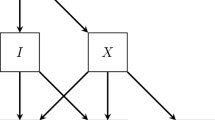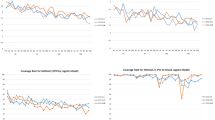Abstract
Causal variance decompositions for a given disease-specific quality indicator can be used to quantify differences in performance between hospitals or health care providers. While variance decompositions can demonstrate variation in quality of care, causal mediation analysis can be used to study care pathways leading to the differences in performance between the institutions. This raises the question of whether the two approaches can be combined to decompose between-hospital variation in an outcome type indicator to that mediated through a given process (indirect effect) and remaining variation due to all other pathways (direct effect). For this purpose, we derive a causal mediation analysis decomposition of between-hospital variance, discuss its interpretation, and propose an estimation approach based on generalized linear mixed models for the outcome and the mediator. We study the performance of the estimators in a simulation study and demonstrate its use in administrative data on kidney cancer care in Ontario.







Similar content being viewed by others
Availability of data and material
The data that support the findings of this study are available from ICES (https://www.ices.on.ca/). Restrictions apply to the access to these data, which were used under agreement for this study.
Code availability
R code to reproduce the simulation study will be made available at the Journal website.
References
Baron, R.M., Kenny, D.A.: The moderator-mediator variable distinction in social psychological research: conceptual, strategic, and statistical considerations. J. Personal. Soc. Psychol 51(6), 1173–1182 (1986)
Bates, D., Mächler, M., Bolker, B., Walker, S.: Fitting linear mixed-effects models using lme4. J. Stat. Softw. 67(1), 1–48 (2015)
Bragayrac, L.A.N., Abbotoy, D., Attwood, K., Darwiche, F., Hoffmeyer, J., Kauffman, E.C., Schwaab, T.: Outcomes of minimal invasive vs open radical nephrectomy for the treatment of locally advanced renal-cell carcinoma. J. Endourol. 30(8), 871–876 (2016)
Chen, B., Saarela, O.: Hierarchical causal variance decomposition for institution and provider comparisons in healthcare (2020) arXiv preprint arXiv:200507314
Chen, B., Lawson, K.A., Finelli, A., Saarela, O.: Causal variance decompositions for institutional comparisons in healthcare. Stat. Methods Med. Res. 29(7), 1972–1986 (2020)
Daignault, K., Lawson, K.A., Finelli, A., Saarela, O.: Causal mediation analysis for standardized mortality ratios. Epidemiology 30(4), 532–540 (2019)
de Heus, P.: R squared effect-size measures and overlap between direct and indirect effect in mediation analysis. Behav. Res. Methods 44(1), 213–221 (2012)
Derkach, A., Pfeiffer, R.M., Chen, T., Sampson, J.N.: High dimensional mediation analysis with latent variables. Biometrics 75(3), 745–756 (2019)
Donabedian, A.: The quality of care. How can it be assessed? JAMA 260(12), 1743–1748 (1988)
Fairchild, A.J., MacKinnon, D.P., Taborga, M.P., Taylor, A.B.: R 2 effect-size measures for mediation analysis. Behav. Res. Methods 41(2), 486–498 (2009)
Fisher, A., Rudin, C., Dominici, F.: All models are wrong, but many are useful: learning a variable’s importance by studying an entire class of prediction models simultaneously. J. Mach. Learn. Res. 20(177), 1–81 (2019)
Goldstein, H., Spiegelhalter, D.J.: League tables and their limitations: statistical issues in comparisons of institutional performance. J. R. Stat. Soc. Series A 159, 385–443 (1996)
Lachowicz, M.J., Preacher, K.J., Kelley, K.: A novel measure of effect size for mediation analysis. Psychol. Methods 23(2), 244 (2018)
Lange, T., Thygesen, L.C., Rasmussen, M.: Assessing natural direct and indirect effects through multiple pathways. Am. J. Epidemiol. 179(4), 513–518 (2014)
Larsen, K., Merlo, J.: Appropriate assessment of neighborhood effects on individual health: integrating random and fixed effects in multilevel logistic regression. Am. J. Epidemiol. 161(1), 81–88 (2005)
Liu, Q., Shepherd, B.E., Li, C., Harrell, F.E.: Modeling continuous response variables using ordinal regression. Stat. Med. 36(27), 4316–4335 (2017)
Loeys, T., Moerkerke, B., Vansteelandt, S., Steen, J.: Flexible mediation analysis with multiple mediators. Am. J. Epidemiol. 186(2), 184–193 (2017)
Miočević, M., O’Rourke, H.P., MacKinnon, D.P., Brown, H.C.: Statistical properties of four effect-size measures for mediation models. Behav. Res. Methods 50(1), 285–301 (2018)
Newton, M.A., Raftery, A.E.: Approximate Bayesian inference with the weighted likelihood bootstrap. J. R. Stat. Soc. Series B (Methodol.) 56(1), 3–26 (1994)
Preacher, K.J., Zyphur, M.J., Zhang, Z.: A general multilevel SEM framework for assessing multilevel mediation. Psychol. Methods 15(3), 209 (2010)
Racz, M.J., Sedransk, J.: Bayesian and frequentist methods for provider profiling using risk-adjusted assessments of medical outcomes. J. Am. Stat. Assoc. 105, 48–58 (2010)
Rubin, D.B., Rosenbaum, P.R.: The central role of the propensity score in observational studies for causal effects. Biometrika 70(1), 41–55 (1983)
Semerjian, A., Zettervall, S.L., Amdur, R., Jarrett, T.W., Vaziri, K.: 30-day morbidity and mortality outcomes of prolonged minimally invasive kidney procedures compared with shorter open procedures: National surgical quality improvement program analysis. J. Endourol. 29(7), 830–837 (2015)
Shahian, D.M., Normand, S.L.T.: Comparison of “risk-adjusted” hospital outcomes. Circ. J. Am. Heart Assoc. 117, 1955–1963 (2008)
Skrondal, A., Rabe-Hesketh, S.: Generalized latent variable modeling: multilevel, longitudinal, and structural equation models. CRC Press, Boca Raton (2004)
Tofighi, D., Thoemmes, F.: Single-level and multilevel mediation analysis. J. Early Adolesc. 34(1), 93–119 (2014)
Van der Vaart, A.W.: Asymptotic statistics. Cambridge University Press, Cambridge (2000)
VanderWeele, T., Vansteelandt, S.: Conceptual issues concerning mediation, interventions and composition. Stat. Interface 2, 457–468 (2009)
VanderWeele, T., Vansteelandt, S., Robins, J.: Effect decomposition in the presence of an exposure-induced mediator-outcome confounder. Epidemiology 25(2), 300–306 (2014)
Varewyck, M., Goetghebeur, E., Eriksson, M., Vansteelandt, S.: On shrinkage and model extrapolation in the evaluation of clinical center performance. Biostatistics 15(4), 651–664 (2014)
Xia, L., He, K., Li, Y., Kalbfleisch, J.: Accounting for total variation and robustness in profiling health care providers. Biostatistics (Oxford, England), (2020)
Yee, T.W., Stoklosa, J., Huggins, R.M.: The VGAM package for capture-recapture data using the conditional likelihood. J. Stat. Softw. 65(5), 1–33 (2015)
Zigler, C.K., Ye, F.: A comparison of multilevel mediation modeling methods: recommendations for applied researchers. Multivar. Behav. Res. 54(3), 338–359 (2019)
Acknowledgements
This work was supported by a Discovery Grant from the Natural Sciences and Engineering Research Council of Canada (to OS), a Catalyst Grant in Health Services and Economics Research from the Canadian Institutes of Health Research (to AF, KAL and OS) and the Ontario Institute for Cancer Research through funding provided by the Government of Ontario (to BC). This study contracted ICES Data & Analytic Services (DAS) and used de-identified data from the ICES Data Repository, which is managed by ICES with support from its funders and partners: Canada’s Strategy for Patient-Oriented Research (SPOR), the Ontario SPOR Support Unit, the Canadian Institutes of Health Research and the Government of Ontario. The opinions, results and conclusions reported are those of the authors. No endorsement by ICES or any of its funders or partners is intended or should be inferred. Parts of this material are based on data and information compiled and provided by CIHI. However, the analyses, conclusions, opinions and statements expressed herein are those of the author, and not necessarily those of CIHI. Parts of this material are based on data and information provided by Cancer Care Ontario (CCO). The opinions, results, view, and conclusions reported in this paper are those of the authors and do not necessarily reflect those of CCO. No endorsement by CCO is intended or should be inferred.
Author information
Authors and Affiliations
Corresponding author
Ethics declarations
Conflict of interest
The authors declare no potential conflicts of interest with respect to the research, authorship, and/or publication of this article.
Ethics approval
Our study was approved by the Research Ethics Board of the University Health Network, Toronto, Ontario.
Consent to participate
Please see https://www.ices.on.ca/Data-and-Privacy/ICES-data/Working-with-ICES-Data.
Consent for publication
Please see https://www.ices.on.ca/Data-and-Privacy/ICES-data/Working-with-ICES-Data.
Additional information
Publisher's Note
Springer Nature remains neutral with regard to jurisdictional claims in published maps and institutional affiliations.
Rights and permissions
About this article
Cite this article
Chen, B., Lawson, K.A., Finelli, A. et al. Causal mediation analysis decomposition of between-hospital variance. Health Serv Outcomes Res Method 22, 118–144 (2022). https://doi.org/10.1007/s10742-021-00256-6
Received:
Revised:
Accepted:
Published:
Issue Date:
DOI: https://doi.org/10.1007/s10742-021-00256-6




